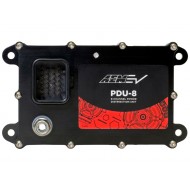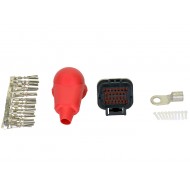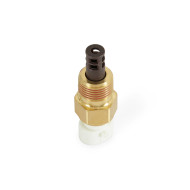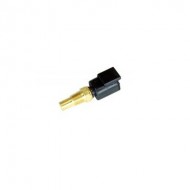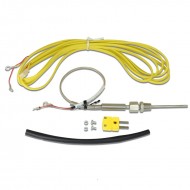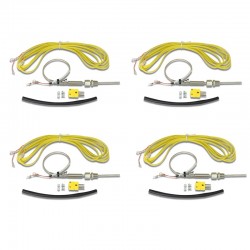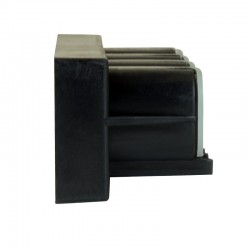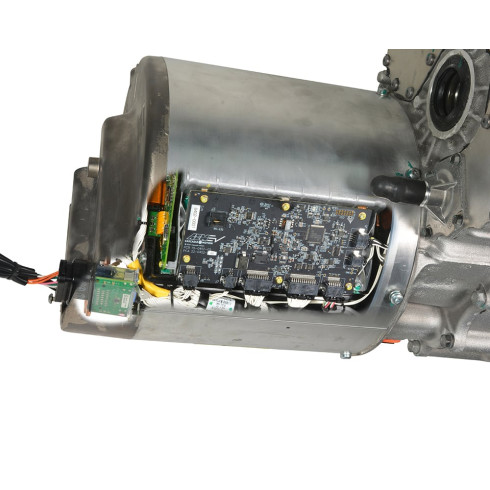
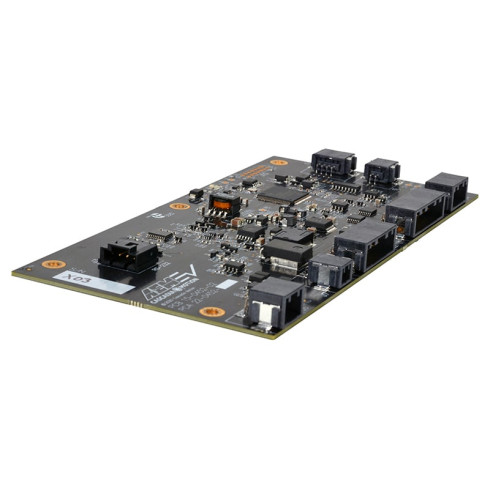
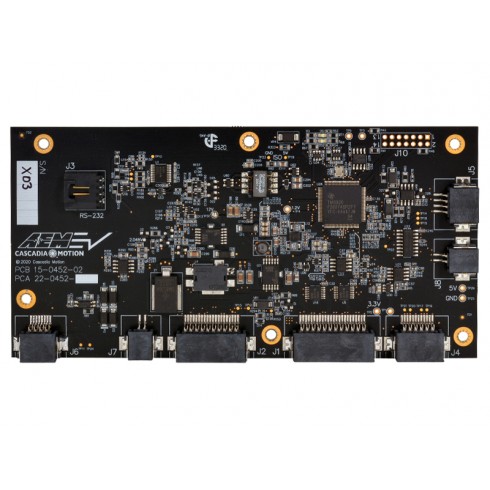





Install a Tesla Model S or Model X
"P" (P90D, P100D) Large Drive Unit (LDU) in any vehicle and achieve
complete control with AEM EV’s LDU Inverter Control Board (ICB, PN 30-8402) and
VCU200 Vehicle Control Unit (PN 30-8000)! This system provides full control of
the LDU for programming torque curves, torque limits, regenerative braking,
accelerator pedal response, drive-mode switches, and much more. The Tesla LDU
currently comes in two versions, Base and Sport.
AEM EV’s Tesla Inverter Control Board acts as
a VCU expansion device that replaces the stock Tesla ICB. Once connected to a
VCU200 using the supplied communications harness, calibrators can program
propulsion strategies and characterize inputs through the VCU using AEMcal
software. AEM EV’s LDU ICB was co-developed with Cascadia Motion, an industry
leader in EV propulsion systems, to ensure the highest standards of quality and
reliability.
NOTE: The Inverter Control Board must be used
with a VCU200 Vehicle Control Unit for programming and controlling a Tesla LDU.
This system is designed for conversion and motorsports vehicles with Tesla LDU
swaps. It will not control a Tesla LDU in a Tesla OE chassis
.
Improved Performance Over Stock
AEM EV’s engineers were able to increase the
peak torque output of the Base LDU using the AEM EV LDU controls system. The
following dyno chart shows a +50Nm torque increase with the AEM EV VCU &
Tesla LDU ICB over the stock torque level.
TEST 1: The green trace is a Base LDU with OE
Tesla control board used with a competitor CAN spoofer control device. The red
trace is the same Base LDU with AEM EV controls package. Average peak torque
from the OE control board is 415Nm and average peak torque from AEM EV controls
package is 465Nm – a +50Nm gain! Both tests were completed at the same HV
voltage level using AEM EV’s stationary dyno power supply.
It's important to note that the motor’s
maximum achievable power output is highly dependent upon the HV battery’s
discharge characteristics. Certain battery cell types and battery pack
configurations will lend themselves to making more overall power. Because of
this, AEM is not able to guarantee a specific power output, however, the peak
torque output should almost always be achievable. Ultimately, since power
directly correlates to torque and rpm, peak power will always be based on how
long the motor’s peak torque can be made which is directly related to the
battery’s discharge power capability.
A comparison that highlights this point can be
seen in the following dyno chart the shows the different power levels that can
be achieved with a Base LDU depending on battery discharge characteristics.
TEST 2: The blue trace is a Base model 2013
Model S P85 with Base LDU and stock 85kWh battery pack. The green trace is the
AEM EV R&D development car, the “TesTang”, a 2007 Ford Mustang GT with Base
LDU swap and hybrid minivan batteries. The red trace is the AEM EV R&D dyno
test rig with Base LDU and stationary dyno power supply (130kWh energy
capacity, 1700Amp DC discharge rating). The +50Nm torque gain is realized with
the AEM EV controls package over stock but it’s important to note that how long
the motor’s maximum torque output can be sustained will determine the ultimate
power level. For instance, with the lower torque output and limited battery
discharge capability, the stock Model S is only capable of making ~250kW of
power. The AEM EV TesTang with increased torque output and high-power hybrid
batteries can sustain a significantly boosted torque curve that results in more
power – 300kW peak giving a +50kw performance advantage over a stock Base Model
S 85. A more extreme example of this is with the very large, very powerful
stationary battery/power supply used by AEM EV for motor/inverter development.
With 1700Amps of DC discharge capability and minimal voltage sag, the Base
LDU’s torque curve is further boosted and results in a peak power output of
nearly 350kW! Although it may be difficult to physically house a battery of
this size in a road vehicle, this represents the possibility of realizing a
+100kW power increase over a stock Model S with a Base LDU!
Other improved performance aspects include the
elimination of any hard-coded motor speed limiters as well as HV battery
voltage limits*. Through testing, it was observed that the stock Tesla LDU
controls will limit motor speed to 14,500-15,200 rpm. The AEM EV controls
package completely removes this limitation and allows motor speeds up to the
max advised mechanical motor speed of 18,000 rpm allowing for higher ultimate
vehicle speeds. It has additionally been observed that the stock Tesla LDU
controls limit allowed maximum battery voltage to 404 volts. HV battery supply
voltage will directly impact the motor’s ultimate power output and allowing for
a higher supply voltage will result in more power. The AEM EV Tesla LDU ICB has
no hard-coded voltage limit, but the inverter’s 450-volt DC link capacitor
rating should always be observed.
* The ability to apply higher
RPM and voltage to increase a Tesla Drive Unit’s power may result in
degradation of the unit.
Comprehensive Control Through a
Central Interface
AEM EV’s optional CAN expansion modules can
provide additional data channels, our CAN-based modular battery management
system integrates seamlessly with any AEM EV VCU-controlled vehicle, our
CAN-based PDU-8 Power Distribution Units provide accessory control over
switched functions, and data visualization/logging of any and all channels from
devices on any connected CAN network is possible using AEM EV’s CD Carbon
logging dash displays. All programming for our BMS and PDU-8 modules is
performed in AEMcal software for the VCU200 and VCU300.
Intuitive Software
AEMcal software for AEM EV VCUs simplifies the
process of customizing the power delivery strategies and controlling all the
ancillary subsystems of EV motorsports and conversion vehicles. AEMcal software
is free to download, and it is fully enabled (not a demo version), allowing
users to explore its full suite of features and capabilities.
Utilizing a simplified
and intuitive graphical interface that combines tables and graphs for
implementing strategies for torque delivery, launch control (stationary and
dynamic), traction control, regenerative braking, speed limiting, map switching
and more, AEMcal software puts an end to the need for stacking multiple
controllers to control an EV's propulsion and ancillary systems. AEMcal
software is available for download on the Software page.
- Stock: In Stock
- Model: 30-8402
- Weight: 1.40lb
- SKU: 30-8402
- UPC: 840879027179



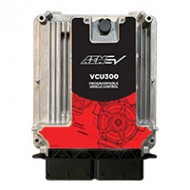
%20Control%20Board/0449a3b8df2fb598e09dd83ad91a067955b3c7bc-190x190w.jpg)
%20Control%20Board/f68202fc36db25c9dcec801391c0f456cb757423-190x190w.jpg)
